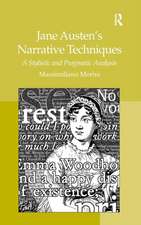Narratives of Women and Murder in England, 1680–1760: Deadly Plots
Autor Kirsten T. Saxtonen Limba Engleză Hardback – 28 iul 2009
| Toate formatele și edițiile | Preț | Express |
|---|---|---|
| Paperback (1) | 338.33 lei 6-8 săpt. | |
| Taylor & Francis – 11 noi 2016 | 338.33 lei 6-8 săpt. | |
| Hardback (1) | 820.03 lei 6-8 săpt. | |
| Taylor & Francis – 28 iul 2009 | 820.03 lei 6-8 săpt. |
Preț: 820.03 lei
Preț vechi: 1140.54 lei
-28% Nou
Puncte Express: 1230
Preț estimativ în valută:
156.91€ • 170.98$ • 132.22£
156.91€ • 170.98$ • 132.22£
Carte tipărită la comandă
Livrare economică 23 aprilie-07 mai
Preluare comenzi: 021 569.72.76
Specificații
ISBN-13: 9780754663645
ISBN-10: 0754663647
Pagini: 162
Dimensiuni: 156 x 234 mm
Greutate: 0.46 kg
Ediția:1
Editura: Taylor & Francis
Colecția Routledge
Locul publicării:Oxford, United Kingdom
ISBN-10: 0754663647
Pagini: 162
Dimensiuni: 156 x 234 mm
Greutate: 0.46 kg
Ediția:1
Editura: Taylor & Francis
Colecția Routledge
Locul publicării:Oxford, United Kingdom
Cuprins
Contents: Introduction; Imagining murder in Augustan England: bodies of evidence; murder and gender; Moving violations: Aphra Benn, Delarivier Manley, and the romance of violence; 'Interesting memoirs of the most notorious characters': four 18th-century murderesses; 'The confines of virtue and the frontiers of vice': Daniel Defoe's Roxana, and Henry Fielding's Amelia; 'The prisoner at the bar': Mary Blandy and Henry Fielding; Epilogue; Select bibliography; Index.
Notă biografică
Kirsten Saxton is an Associate Professor of English at Mills College in Oakland, California, USA.
Recenzii
’The narrativising of murder is the focus of Kirsten Saxton's lively and engaging study... Saxton's writing is witty and colourful and she engages a wide range of visual and written sources... Saxton's compelling and provocative study is to be welcomed for the light it begins to shed on one of our enduring objects of cultural fascination.’ Review of English Studies 'Kirsten Saxton has created a very valuable piece of scholarship for those interested in print accounts of female murderers in the long eighteenth century.' Journal of British Studies 'Narratives of Women and Murder in England is important as the first booklength study of the complex and conflicting relations among femininity, criminal violence, and narrative in eighteenth-century England. It is lively and strongly argued, and departs from previous work on criminality and gender in productive and provocative ways.' 1650-1850: Ideas, Aesthetics and Inquiries in the Early Modern Era 'Narratives of Women and Murder is a compellingly written account that reveals the social constructs underlying narratives of both real and imagined crime.' Notes and Queries
Descriere
Arguing for the centrality of the female criminal subject to the rise of the British novel, Kirsten Saxton compares representations of homicidal women in legal documents with those in the early novels of Behn, Manley, Defoe, and Fielding. She demonstrates that legal narratives informed the novel's evolution and fictional texts shaped the development of legal narratives, and suggests that Augustan configurations of the murderess continue to influence our legal and social conceptions of femininity.








